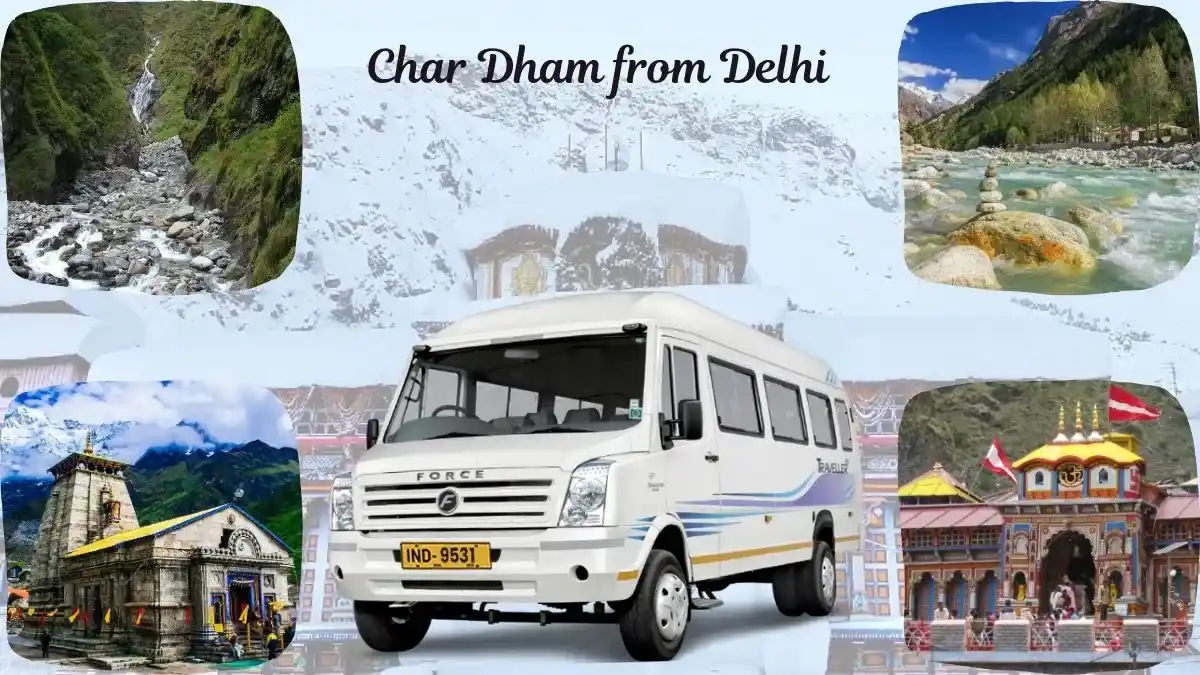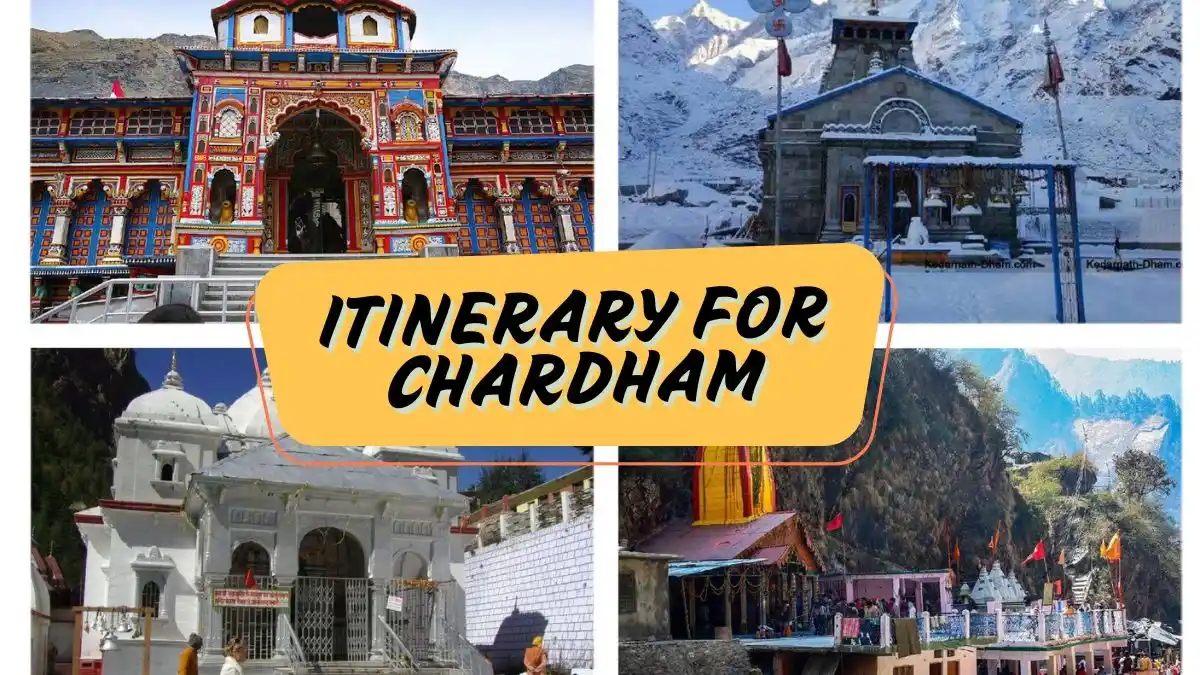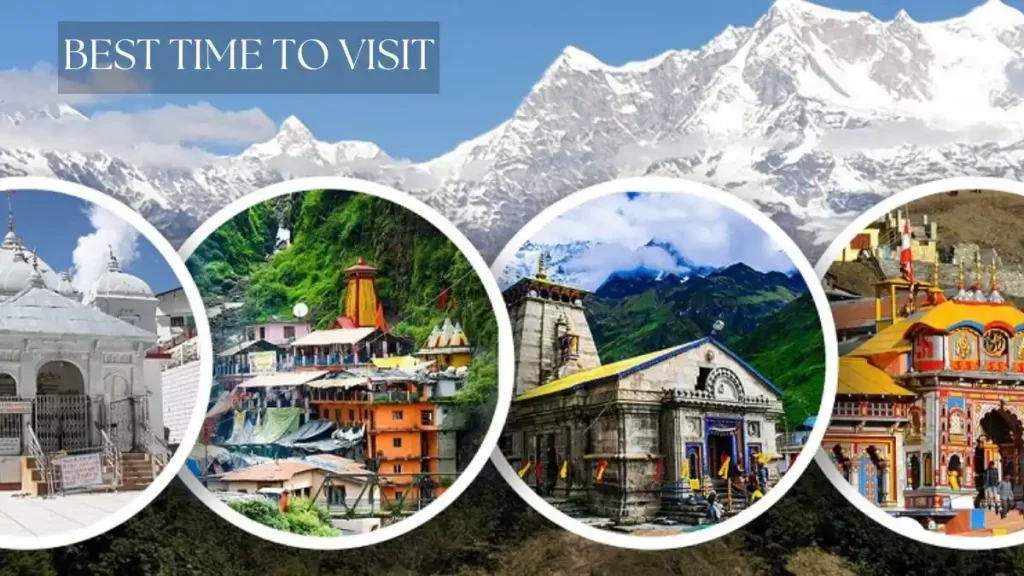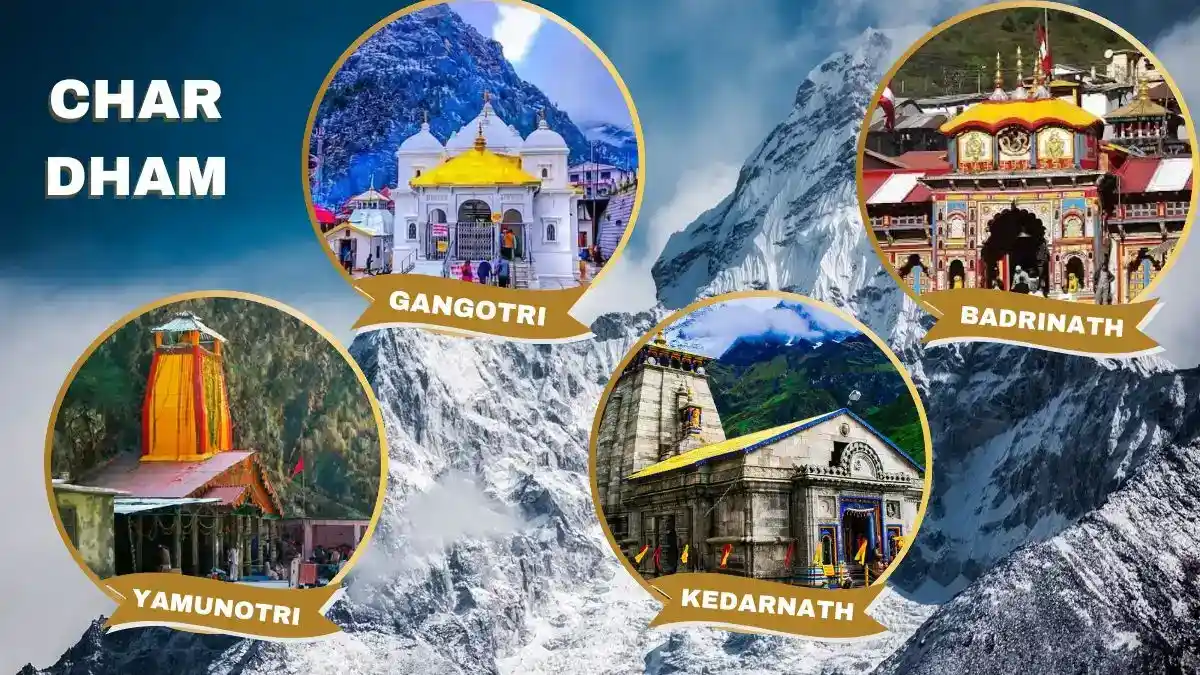Planning a Char Dham Yatra from Delhi is not just about booking tickets and departing. It’s about understanding the geography, the challenges and the spiritual depth of the journey. Did you know that the distance of Delhi to Char Dham Yatra is over 1400 km and you have to travel through some of the most rugged Himalayan terrain?
The Yatra covers Yamunotri, Gangotri, Kedarnath and Badrinath in sequence. The route is designed to help the body acclimatize to the altitude. If you change the sequence, you might feel exhausted or even sick. Many travellers assume that booking a package is enough but without understanding the route, weather, and necessary preparations, they may face unexpected challenges.
For this trip, you have to consider a few things such as What is the best time to go? How to arrange transportation? What permits are required? Can senior citizens complete the journey safely? This guide will answer all these questions and share insights that are often missed.
Some common mistakes can make or break your trip. Even choosing the wrong time of the year can turn a spiritual journey into a trek. This blog will help you avoid those pitfalls and plan a smooth and pleasant Chardham yatra.
Char Dham Opening and Closing Dates 2025
Char Dham Yatra requires careful planning as the temples are open only for six months due to extreme weather conditions in the Himalayas. The opening dates are announced on Basant Panchami and Maha Shivratri and closing dates coincide with Diwali and Bhai Dooj.
The journey is Yamunotri, Gangotri, Kedarnath and then finally Badrinath. The temples open in late April or early May and close in late October or early November. If you plan it early in the season you may get cold weather and occasional snowfall. If you plan it towards the closing date you may get unpredictable road conditions.
| Temple | Opening Date (Tentative) | Closing Date (Tentative) |
| Yamunotri | 30 April 2025 | 2nd November 2025 |
| Gangotri | 30 April 2025 | 2nd November 2025 |
| Kedarnath | 02 May 2025 | 3rd November 2025 |
| Badrinath | 04 May 2025 | 9th November 2025 |
How to Reach Char Dham from Delhi?
By Helicopter
It is the fastest way to start the yatra. The nearest airport is Jolly Grant Airport in Dehradun which is 285 km from Yamunotri. From there you need to hire taxis or buses to reach your destination. Helicopter services from Dehradun’s Sahastradhara Helipad is another option. Full Chardham helicopter packages start from ₹1.7 lakh per person. As the helicopter seats are limited, bookings should be made months in advance.
By Train
This is an economical option but does not provide direct connectivity to temples. The nearest major railway stations are Haridwar, Rishikesh and Dehradun. Haridwar has excellent train connectivity with Delhi through Shatabdi Express, Jan Shatabdi and Mussoorie Express. Rishikesh Railway Station is another option but has fewer train services. Dehradun Railway Station is best for those going to Gangotri and Yamunotri. After reaching these railway stations you need to continue by road.
By Road

The Road is the most preferred way to do Chardham Yatra. The journey starts from Delhi to Haridwar or Rishikesh and then to Yamunotri, Gangotri, Kedarnath and Badrinath in sequence. Each leg of the journey requires good time management as landslides and traffic jam are common. Bus rental services and shared taxis are available on these routes but hiring a private vehicle gives more flexibility. For groups hiring a tempo traveller is one of the best and most comfortable ways to do Chardham Yatra. The cost of tempo traveller from Delhi to Chardham is between ₹90,000 to ₹1,20,000. Lesser-known travel hacks are to start the journey early in the morning to avoid roadblocks and to travel on weekdays to avoid peak rush.
Itinerary for Char Dham Yatra from Delhi

A well-planned itinerary ensures a smooth and spiritually enriching Char Dham Yatra. The journey of Delhi to Chardham Yatra is of around 11 nights and 12 days which covers approximately 1,400 kilometers.
This is the Char Dham Yatra Route Map:
Delhi-Haridwar-Barkot-Janki Chatti-Yamunotri-Uttarkashi-Gangotri-Rudraprayag-Gaurikund-Kedarnath-Gaurikund-Rudraprayag-Badrinath-Rishikesh-Delhi
Day 1: Delhi to Haridwar (220 km / 6 hours)
Start early in the morning. The road from Delhi to Haridwar is full of pilgrims, tourists and heavy vehicles. The journey takes 6 hours. If you are traveling in peak season, expect traffic jams. Reach Haridwar and check in to your hotel and freshen up. Visit Har Ki Pauri in the evening to see the Ganga Aarti. If you want to explore then visit the Bharat Mata Mandir.
Day 2: Haridwar to Barkot (180 km / 7 hours)
Leave early to avoid the rush on the Haridwar-Rishikesh highway. But the road after Rishikesh is steep and curvy. Stop at Kempty Falls near Mussoorie for a break. The drive gets tougher as you move towards Barkot. Reach Barkot and check in to a hotel or guesthouse. Most of the accommodations here are basic so don’t expect luxury
Day 3: Barkot to Yamunotri and back (36 km drive + 6 km trek)
Early morning drive to Janki Chatti, the last motorable point before Yamunotri. The 6 km trek to the temple is challenging. If you are not used to trekking, hire a pony or palanquin. Most people don’t know that the Yamunotri temple closes by 2 PM for a break so plan your trek accordingly. Before entering the temple take a dip in the Surya Kund hot spring. The water here is naturally boiling. People cook rice in it as an offering to the goddess. After darshan trek back and come to Barkot.
Day 4: Barkot to Uttarkashi (90 km / 4 hours)
After breakfast leave Barkot and head to Uttarkashi. The road to Uttarkashi is full of sharp turns. Visit Vishwanath Temple which is older than Kashi Vishwanath Temple in Varanasi. Many people skip Nehru Institute of Mountaineering but it’s worth a stop.
Day 5: Uttarkashi to Gangotri and back (200 km / 8 hours)
Start early the road to Gangotri is unpredictable. Landslides are common in this region. On the way stop at Harsil a hidden gem known for its apple orchards and beauty. On reaching Gangotri take a holy dip in the freezing waters of Bhagirathi River. Visit the temple and nearby places like Pandava Gufa where Pandavas are believed to have meditated. After darshan return to Uttarkashi before sunset.
Day 6: Uttarkashi to Guptkashi (220 km / 9 hours)
Leave early in the morning as the drive to Guptkashi is long and tough. Stop at Tehri Dam one of the highest dams in the world but don’t spend too much time as the journey is tiring. Lord Shiva hid here from Pandavas before finally revealing himself at Kedarnath. Check into a basic hotel as there are no luxury stays in this region.
Day 7: Guptkashi to Kedarnath (30 km drive + 16 km trek)
Start early in the morning and drive to Gaurikund. This is the last motorable point before Kedarnath. From their 16 km trek is the most difficult part of the Char Dham Yatra. If you are not a regular trekker, take a pony or palki. Helicopter services are available from Phata but you need to book in advance. The trek to last 5 km is the toughest. Once you reach Kedarnath, the atmosphere is unique. The 1200 year old temple stands tall against the Himalayas. Attend the evening aarti which is beyond words.
Day 8: Kedarnath to Guptkashi (16 km trek + 30 km drive)
Wake up before dawn to see the first aarti of the day. The morning at Kedarnath is magical. After darshan start your descent to Gaurikund. At Gaurikund take some rest. The hot water springs here are believed to have medicinal properties but few people take advantage of it. After a short break drive back to Guptakashi. Spend the evening relaxing as the next journey is long.
Day 9: Guptkashi to Badrinath (200 km / 8 hours)
Leave early as the journey to Badrinath is long. The route passes through Chopta which is called the Mini Switzerland of India. Joshimath is the most important stop before Badrinath. The winter seat of Lord Badrinath is here in the Narasimha Temple. Many devotees visit Badrinath only and miss this temple which is so important historically and religiously.
Visit the temple in the evening and take a dip in Tapt Kund before darshan. The natural hot spring here is said to wash away sins. The evening aarti at Badrinath is an experience. Stay in Badrinath.
Day 10: Badrinath to Rudraprayag (160 km / 6 hours)
If you missed the morning rituals, wake up early and visit the temple again. Visit Mana Village which is the last Indian village before Tibet. Then visit Bhim Pul a natural rock bridge believed to be built by Bhima from Mahabharata. Then visit Vasudhara Falls which is a hidden gem 5 km ahead.
After Mana Village start driving towards Rudraprayag. It’s famous for the confluence of Alaknanda and Mandakini rivers. This is where Jim Corbett shot the famous Man Eating Leopard of Rudraprayag.
Day 11: Rudraprayag to Rishikesh (140 km / 5 hours)
Drive to Rishikesh which is not just a tourist town but a global hub of spirituality and yoga. Visit Ram Jhula and Laxman Jhula which have interesting mythological stories attached to them. If you want to do something different visit the Beatles Ashram where the band stayed.
If you love adventure this is the best place for river rafting. Attend the grand Ganga Aarti at Triveni Ghat in the evening.
Day 12: Rishikesh to Delhi (240 km / 6 hours)
This is the last leg of your journey. Drive back to Delhi with a heart full of divine memories. This pilgrimage is not just about visiting temples. It’s about experiencing the raw beauty of Himalayas and understanding the depth of India’s spiritual heritage.
If you are looking to start your Chardham Yatra from Haridwar and booked a GMVN package, travel to Haridwar from Delhi by road for a quick journey.
Best Time to Do Char Dham Yatra

The best time to do Char Dham Yatra is May-June or September-October. Yatra officially starts in late April or early May depending on temple openings. May-June is ideal as weather is pleasant and roads are open. But this is also peak season so expect heavy crowds and long waiting times at temples. July to early September should be avoided as there are landslides, road blocks and unpredictable weather.
Many people don’t know that September and early October are the best time to visit. Weather is cool, crowds are thin and landscapes are at their best after monsoons. October also has a spiritual atmosphere as it coincides with many Hindu festivals so it adds a special charm to the pilgrimage.
Char Dham Yatra Registration
Char Dham Yatra registration is a must for the safety and tracking of pilgrims. Many don’t know that they can register both online and offline. Online registration can be done through Uttarakhand Tourism Department’s official website- https://registrationandtouristcare.uk.gov.in/ where you get an e-pass or by using a Mobile app. Offline registration is available at Haridwar, Rishikesh and Sonprayag check posts. You need to carry a government issued ID, passport size photos and a medical certificate for the verification. Text “Yatra” to +91-8394833833 on WhatsApp for quick booking.
Biometric registration is also required at some points. This helps the authorities to track your movement and help in case of emergency. Registration is free but be careful of people who offer paid registration services. The government has also introduced RFID tags that track the pilgrims and help in case of accidents or natural disasters.
How to Prepare and Pack for the Chardham Yatra Trip
- Bring a valid ID, multiple photocopies and extra passport sized photos for registration and permits.
- Pack warm clothing including thermals, jackets, gloves and woolen socks as temperatures drop at night.
- Choose waterproof trekking shoes with good grip as the terrain is uneven and slippery in many places.
- Keep essential medicines, first aid kits and altitude sickness tablets as medical facilities are limited in remote areas.
- Bring dry fruits, energy bars and packaged snacks as food options are minimal on long trekking routes.
- Carry power bank, extra batteries and a flashlight as electricity is not reliable in high altitude regions.
- Bring a reusable water bottle and water purification tablets to stay hydrated without plastic bottles.
- Carry cash in small denominations as ATMs are not available and card is not accepted in remote areas.
Final Thoughts
So, If you are reading this blog, and planning for Chardham Tour this year, make your bookings in advance to get best deal on any kind of tempo traveller. You can also book a complete package with Registration, meal, transportation, hotel stay and sightseeing. For a group, a chardham yatra package is highly recommended. If you want to avail services for 2-6 persons, contact us for fixed departure Chardham Yatra which starts from Delhi on fixed dates. It helps in reducing per person travel cost.Planning a Char Dham Yatra from Delhi is not just about booking tickets and departing. It’s about understanding the geography, the challenges and the spiritual depth of the journey. Did you know that the distance of Delhi to Char Dham Yatra is over 1400 km and you have to travel through some of the most rugged Himalayan terrain?

